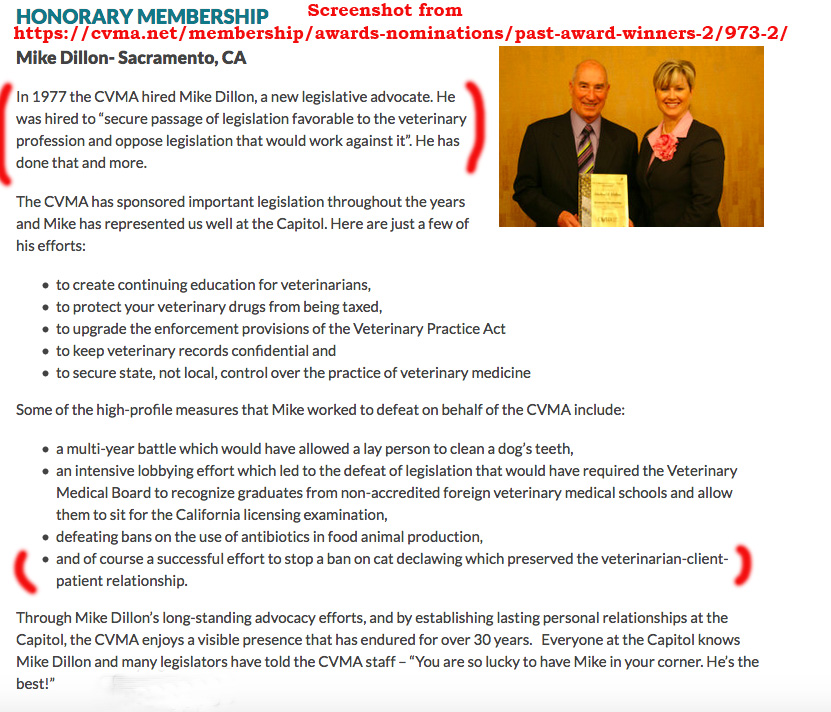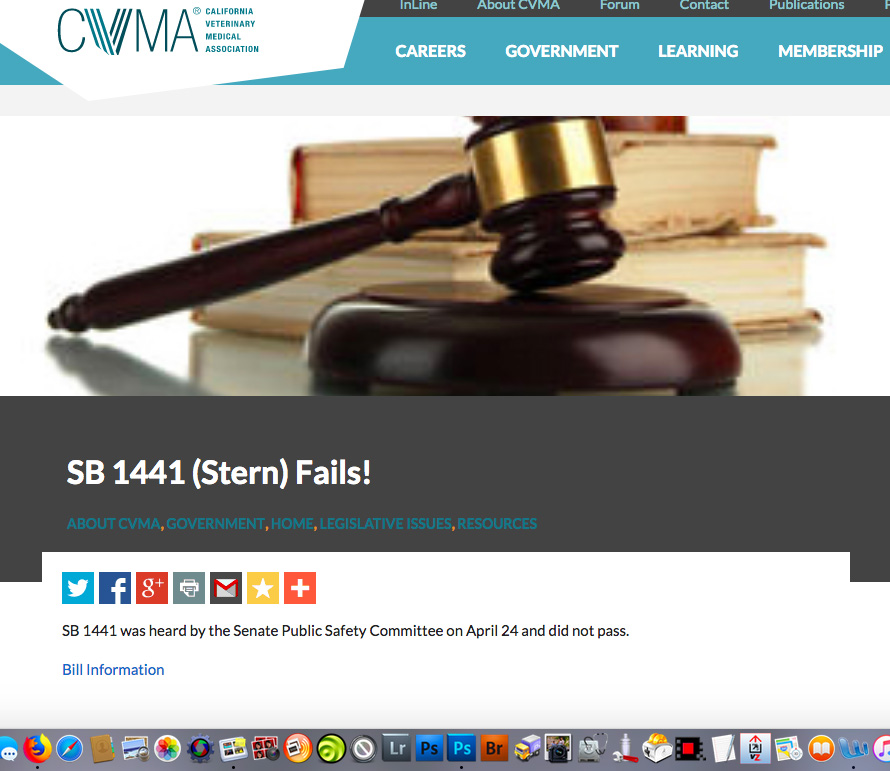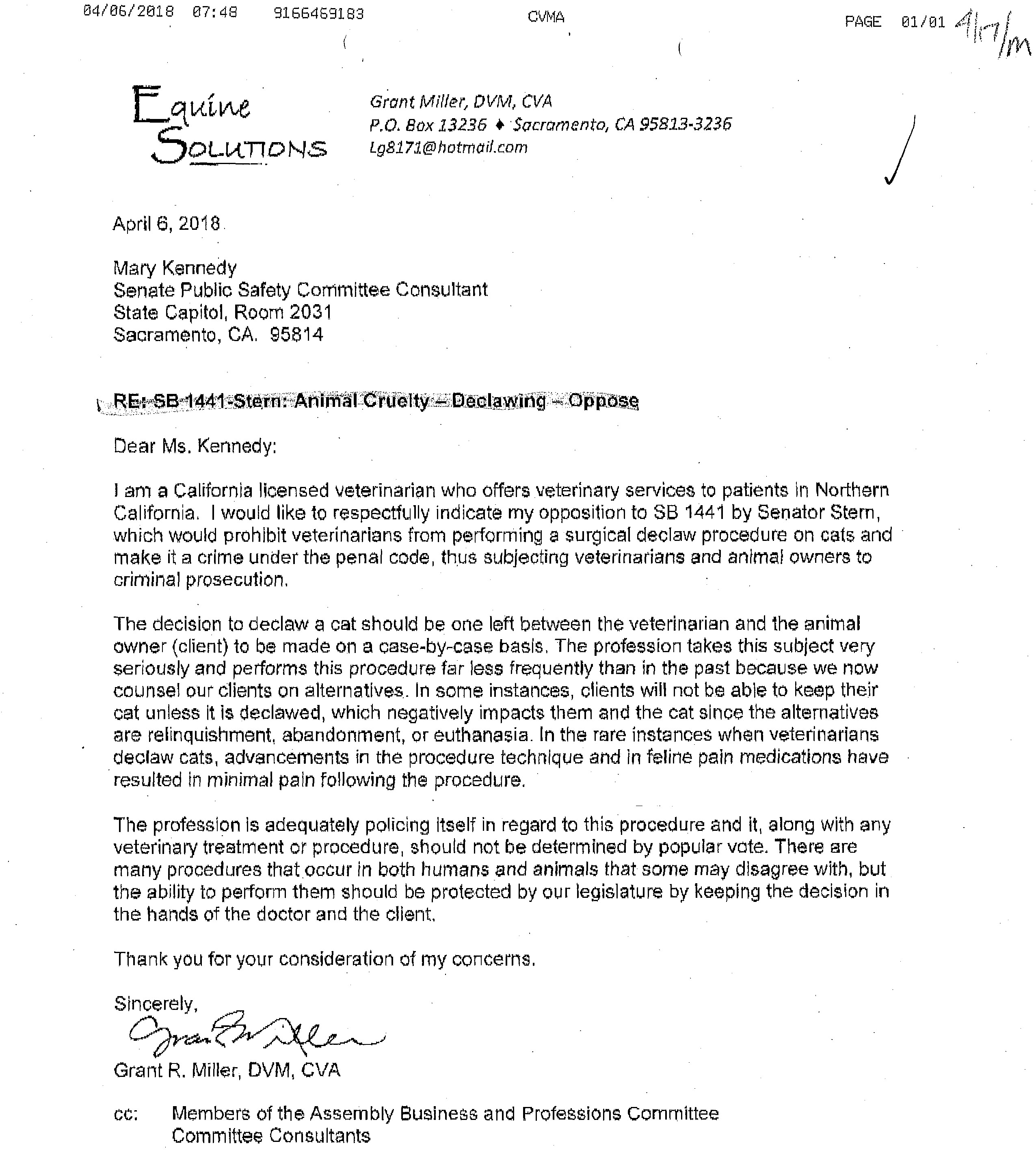
Oppose SB 1441 (Stern): Animal Cruelty – Declawing
The CVMA is alerting the veterinary profession about critical legislation before the California Legislature. SB 1441 (Stern) will be heard in the Senate Public Safety Committee in April and it is strongly opposed by the CVMA.
SB 1441 would amend the Penal Code to make the surgical claw removal, declawing, onychectomy, or tendonectomy of a domestic cat a crime punishable by fine and/or a misdemeanor. It applies to veterinarians performing the surgical procedure and to any person who procures or arranges for the procedure to be done.
On the surface, you may think this bill is only about the declaw procedure. In reality, it criminalizes a legal veterinary surgical procedure and accuses veterinarians and their clients of animal cruelty.
Regardless of personal feelings about this procedure, the decision to perform a treatment or therapy should be made on a case-by-case basis between the veterinarian and the client. While there is an exception for a therapeutic purpose, the bill does not address owners who are elderly, disabled, or immunocompromised who may not be able to own or keep their cats due to this legislation.
During the past two decades, the profession has appropriately and adequately regulated itself in addressing the issue of declawing. The procedure is performed far less today because veterinarians educate and counsel clients on alternatives. When the procedure is performed, advancements in surgical technique and pain management have greatly reduced patient discomfort.
This bill overrides the process of establishing minimum standards of practice that are regulated by the California Veterinary Medical Board and the process that governs a veterinarian’s right to practice. There is a disciplinary process in place regarding when there is a deviation from the standard of practice regarding veterinary medical procedures.
TAKE ACTION NOW
We are asking you to contact members of the Senate Public Safety Committee on or before Monday, April 16, 2018 and oppose SB 1441, which would subject veterinarians to criminal prosecution for performing a surgical declaw procedure on domestic cats. Please send a personal letter outlining the importance of this issue and include your own examples of the importance of animal patient medical care being made by the owner in consultation with the veterinarian.
Your letter should be on your practice letterhead or personal stationery and can be mailed or faxed as indicated on the attached contact information sheet.
CVMA Policy on Declawing of Domestic Cats
The decision to declaw a cat should be made by the owner in consultation with their veterinarian. The veterinarian has an obligation to educate clients on alternatives to the declaw procedure as well as potential surgical complications.
The declawing of cats may become necessary for medical or behavioral reasons or when scratching presents a health risk for the owner(s), and should be used instead of relinquishment, abandonment, or euthanasia.
The procedure shall be performed in a manner that minimizes the risk of complications. Pain management is necessary for this procedure.
Facts
- Veterinarians are trained to distinguish medical and behavioral problems and need to be able to continue to educate and counsel clients.
- Veterinarians do not take the issue of declawing lightly and strive to educate pet owners about available alternatives.
- Claw removal is sometimes medically necessary for conditions such as tumors or chronic infections.
- Studies have proven that behavioral problems are the leading cause of unnecessary relinquishment of animals.
- Not all pet owners are able to successfully train a cat to refrain from using its claws in a destructive manner.* Owners who are elderly or disabled may lack the ability or means to provide the needed training.
*Owners, or those living on or otherwise coming on to the premises, may be immunocompromised and more susceptible to diseases transmitted through feline clawing.
*Still others may be faced with pets that are particularly resistant to training.
- Current surgical techniques and modern anesthetic and pain medications have greatly reduced the pain and discomfort associated with cat declawing.
- Euthanasia, abandonment, or other forms of relinquishment should not be the last resort for the cat owning public.

——————————————————————————————————————————-April 27, 2018
The CVMA posted this on their website after they successfully stopped the anti-declawing bill in California.

The California Veterinary Medical Association opposes this bill stating:
SB 1441 attempts to circumvent [Business and Professions Code] Section 460 by amending Section 597.6 of the Penal Code where there is a current prohibition on the surgical declaw of exotic or native wild cate species-to add domestic cats.
SB 1441 (Stern ) Page 5 of 5
Under this proposal, veterinarians would be subject to fines and then a misdemeanor, and perhaps additional criminal penalties for performing a medical surgery at the request of a client. Additionally, we believe clients would be subject to the same penalties for “procuring or arranging” the declawing.
The CVMA is very concerned with the precedent that would be set by Senator Stern’s bill, as it would send that message that when an activist group is not in favor of a certain medical procedure, they would run legislation to place a prohibition on that procedure in the Penal Code in order to get around the restrictions in Section 460. We wonder what procedures would be next to be placed in the Penal Code—spay and neuter procedures, or even those pertaining to human surgeries…
The CVMA wants to stress that declawing is not a regularly performed procedure and the decision to declaw a cat is not made lightly. The decision is made by the animal owner who requests the surgery, and only after the veterinarian has educated the client about the procedure and the possible alternatives….When the procedure is performed, advancements in surgical technique and pain management have greatly reduced patient discomfort and recovery time. If a client is unable to obtain this surgical procedure from a veterinarian, the client faces a tremendous personal conflict of deciding whether to declaw the cat or relinquish that cat to an already over-burdened animal shelter, where it may be euthanized. This is an untenable situation for an owner, particularly an owner who may be undergoing chemotherapy treatment and cannot afford to risk infection brought on by a cat scratch.
Equine Solutions opposes stating:
The decision to declaw a cat should be one left between the veterinarian and animal owner (client) to be made on a case-by-case basis. The profession takes this subject very seriously and performs this procedure far less frequently than in the past because we now counsel our clients on alternatives. In some instances, clients will not be able to keep their cat unless it is declawed, which negatively impacts them and the cat since the alternatives are relinquishment, abandonment, or euthanasia. In the rare instances when veterinarians declaw cats, advancements in the procedure technique and feline pain medications have resulted in minimal pain following the procedure.
The profession is adequately policing itself in regard to this procedure and it, along with any veterinary treatment or procedure, should not be determined by popular vote. There are many procedures that occur in both humans and animals that some may disagree with, but the ability to perform them should be protected by our legislature by keeping the decision in the hands of the doctor and the client.
————————————————————————————————-


